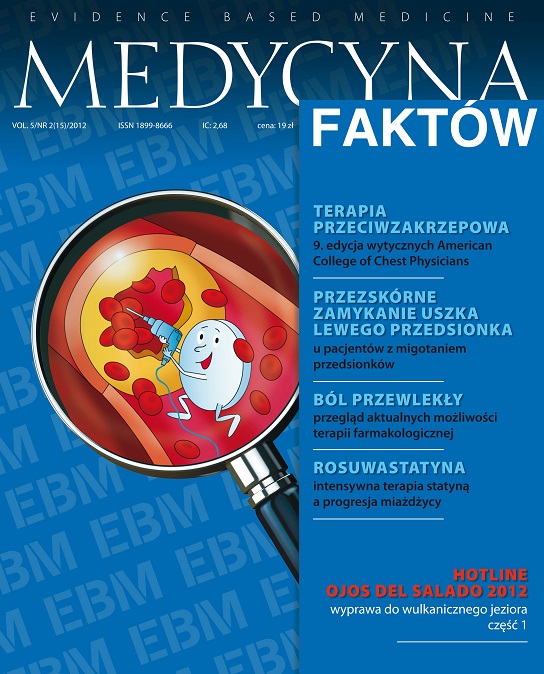Ramipril and its place in current treatment of hypertension Review article
Main Article Content
Abstract
According to current knowledge both arterial blood pressure decrease and cardiovascular risk reduction should be the main goals of arterial hypertension treatment.
Ramipril is an angiotensin-converting enzyme inhibitor with confirmed safety and efficacy in reducing mortality and cardiovascular outcomes risk in many groups of patients. Ramipril is beneficial among high-risk patients with hypertension organic complications (especially left ventricle hypertrophy), ischemic heart disease with or without myocardial infarction, heart failure, chronic kidney disease, diabetes and metabolic syndrome. The article presents current knowledge from randomized clinical trials and guidelines about role of ramipril in the treatment of arterial hypertension.
Article Details
Copyright © by Medical Education. All rights reserved.
References
2. Mancia G., De Backer G., Dominiczak A. et al.: 2007 Guidelines for the management of arterial hypertension: The Task Force for the Management of Arterial Hypertension of the European Society of Hypertension (ESH) and of the European Society of Cardiology (ESC). Eur. Heart J. 2007 Jun; 28(12): 1462-536.
3. Widecka K., Grodzicki T., Narkiewicz K. et al.: Zasady postępowania w nadciśnieniu tętniczym – 2011 rok. Wytyczne Polskiego Towarzystwa Nadciśnienia Tętniczego. Nadciśnienie Tętnicze 2011; 15(2): 55-82.
4. Graham I., Atar D., Borch-Johnsen K. et al.: European guidelines on cardiovascular disease prevention in clinical practice: full text. Fourth Joint Task Force of the European Society of Cardiology and other societies on cardiovascular disease prevention in clinical practice (constituted by representatives of nine societies and by invited experts). Eur. J. Cardiovasc. Prev. Rehabil. 2007 Sep; 14(Suppl. 2): S1-113.\
5. Centrum Informacji o Leku [online].
6. Yusuf S., Sleight P., Pogue J. et al.: Effects of an angiotensin-converting-enzyme inhibitor, ramipril, on cardiovascular events in high-risk patients. The Heart Outcomes Prevention Evaluation Study Investigators. N. Engl. J. Med. 2000 Jan 20; 342(3): 145-53 (Erratum in: 2000 May 4; 342(18): 1376. N. Engl. J. Med. 2000 Mar 9; 342(10): 748).
7. Mathew J., Sleight P., Lonn E. et al.: Reduction of cardiovascular risk by regression of electrocardiographic markers of left ventricular hypertrophy by the angiotensin-converting enzyme inhibitor ramipril. Circulation 2001 Oct 2; 104(14): 1615-21.
8. Agabiti-Rosei E., Ambrosioni E., Dal Palù C. et al.: ACE inhibitor ramipril is more effective than the beta-blocker atenolol in reducing left ventricular mass in hypertension. Results of the RACE (ramipril cardioprotective evaluation) study on behalf of the RACE study group. J. Hypertens. 1995 Nov; 13(11): 1325-34.
9. Pfeffer M.A., Braunwald E., Moyé L.A. et al.: Effect of captopril on mortality and morbidity in patients with left ventricular dysfunction after myocardial infarction. Results of the survival and ventricular enlargement trial. The SAVE Investigators. N. Engl. J. Med. 1992 Sep 3; 327(10): 669-77.
10. The Acute Infarction Ramipril Efficacy (AIRE) Study Investigators. Effect of ramipril on mortality and morbidity of survivors of acute myocardial infarction with clinical evidence of heart failure. Lancet 1993 Oct 2; 342(8875): 821-8.
11. Kj0ller-Hansen L., Steffensen R., Grande P.: The Angiotensin-converting Enzyme Inhibition Post Revascularization Study (APRES). J. Am. Coll. Cardiol. 2000 Mar 15; 35(4): 881-8.
12. Fox K., Garcia M.A., Ardissino D. et al.: Guidelines on the management of stable angina pectoris: executive summary: The Task Force on the Management of Stable Angina Pectoris of the European Society of Cardiology. Eur. Heart J. 2006 Jun; 27(11): 1341-81.
13. van de Werf F., Bax J., Betriu A. et al.: Management of acute myocardial infarction in patients presenting with persistent ST-segment elevation: the Task Force on the Management of ST-Segment Elevation Acute Myocardial Infarction of the European Society of Cardiology. Eur. Heart J. 2008 Dec; 29(23): 2909-45.
14. Hamm C.W., Bassand J.P., Agewall S. et al.: ESC Guidelines for the management of acute coronary syndromes in patients presenting without persistent ST-segment elevation: The Task Force for the management of acute coronary syndromes (ACS) in patients presenting without persistent ST-segment elevation of the European Society of Cardiology (ESC). Eur. Heart J. 2011 Dec; 32(23): 2999-3054 [online: doi: 10.1093/eurheartj/ehr236].
15. Heart Outcomes Prevention Evaluation Study Investigators. Effects of ramipril on cardiovascular and microvascular outcomes in people with diabetes mellitus: results of the HOPE study and MICRO-HOPE substudy. Lancet 2000 Jan 22; 355(9200): 253-9.
16. Ruggenenti P., Perna A., Gherardi G. et al.: Renal function and requirement for dialysis in chronic nephropathy patients on long-term ramipril: REIN follow-up trial. Gruppo Italiano di Studi Epidemiologici in Nefrologia (GISEN). Ramipril Efficacy in Nephropathy. Lancet 1998 Oct 17; 352(9136): 1252-6.
17. Teo K., Yusuf S., Sleight P. et al.: Rationale, design, and baseline characteristics of 2 large, simple, randomized trials evaluating telmisartan, ramipril, and their combination in high-risk patients: the Ongoing Telmisartan Alone and in Combination with Ramipril Global Endpoint Trial/ Telmisartan Randomized Assessment Study in ACE Intolerant Subjects with Cardiovascular Disease (ONTARGET/TRANSCEND) trials. Am. Heart J. 2004 Jul; 148(1): 52-61.
18. Mann J.F., Schmieder R.E., McQueen M. et al.: Renal outcomes with telmisartan, ramipril, or both, in people at high vascular risk (the ONTARGET study): a multicentre, randomised, double-blind, controlled trial. Lancet 2008 Aug 16; 372(9638): 547-53.

